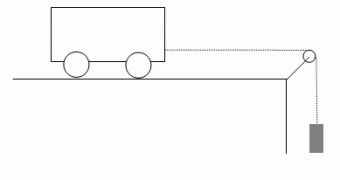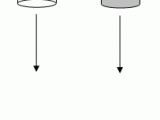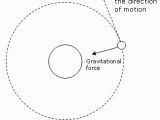More than 300 years after the publication of Newton's revolutionary book on mechanics, Mathematical Principles of Natural Philosophy, the basic insight of that book still remains largely unknown to most people. That basic insight is needed to explain virtually anything that happens around you and involves motion and yet it remains an unintuitive insight. Most people know that Newton has done something in mechanics, but what he has done remains his largely unknown legacy.
The essence of Newton's discovery is quite simple: a force does not move things, a force changes their velocity.
The reason why things start moving when you push them is not that force is moving them, but that their zero speed has been changed by the force. If you continue to push a thing with constant force it will move faster and faster. If it were true that forces move things, a constant force would have moved something with constant speed - but that is not what is happening.
The image below shows a simple experiment that proves this. The weight in used to assure that the cart is pulled with constant force. When you release the weight and let it drop, the cart starts moving and it then moves faster and faster. This happens because the force acting on the cart in each moment increases the cart's current velocity by certain, fixed, amount. (This works in the same way as the compound interest.)
How much is this fixed amount? This fixed amount, called inertia, depends on the body. Some things get accelerated more easily while some are harder to accelerate. But the amazing thing is that this easiness of being accelerated (the inertia) is very simple to determine - it only depends on one single property of the body: its mass.
I want to stress out that this really is an amazing fact. Actually, this remained a mystery until the general theory of relativity was developed in the early 20th century.
The mass is a comparative way of measuring how heavy an object is. An object is heavy because Earth pulls it with a certain force - called gravity. Object A is heavier than object B because it is pulled by the Earth stronger. But in some other place, say on the Moon, the same thing can be less heavy than it is on Earth (or more heavy) because the Moon (or some other body) pulls things with smaller forces (or larger forces).
Nonetheless, the ratio between the weights of any two objects remains the same no matter where you go - it is "invariant to space translation". Mass is the way to describe this invariant feature of the body - so you don't have to worry about where you are. Obviously, the mass of any body is relative to the mass of some arbitrary body chosen to be a unit of mass (the kilogram in Paris). Mass is easy to measure with a balance (a measurement with a balance gives the same result on Earth as well as on the Moon).
So, by saying that inertia depends solely on gravity (and moreover, in a very simple fashion) we are saying that all the forces in the Universe depend on gravity - because the amount of impact any force has on the velocity of a body depends on the inertia of that body. Why this should be so is in no way obvious.
The idea Einstein had used to solve this mystery was to present things the other way around: instead of taking gravity for granted and expressing inertia with it, he asserted that all gravity actually isn't anything else but inertia. In other words, it is not that things are harder or easier to accelerate because they are heavier of lighter but things appear to us heavier or lighter because they look as if they are accelerated more or less. This means that it is assumed that in actual fact everything moves in straight lines with constant speed. To make this crazy idea work, he had to assume that the space and time themselves are curved.
But Newton just noted the simple connection between inertia and mass and used it. So, the point he made was that forces change the velocities of the bodies they act upon and that the amount of this change is inverse proportional to the bodies mass (it's harder to change the velocity of a heavier body).
One strange consequence of this discovery is that if no force is acting upon a body that body will keep its velocity unchanged, whatever that velocity is. (This was actually discovered by Galileo before Newton, but Galileo had no idea what forces do, he only realized what the lack of any force amounted to.) This means that things don't naturally stop their motion - you need to use a force to stop them.
In everyday life this force is of course friction. It is interesting to note that the intuitive idea that forces move things (i.e. that you need a force to change the position of a body) comes from the erroneous assumption that all the forces in the world do nothing else but to counteract friction. It is thus no wonder that the path to the Newtonian mechanics involved precisely a force that does not do this: gravity.
Friction is a force that depends on speed. For example if you move faster you encounter more air molecules in the same amount of time and thus the force against you, that slows you, is higher (friction in a fluid such as air is approximately proportional to the speed). So, in order to move with a constant speed against friction you have to use some force, otherwise friction stops you. This is why we have the impression that forces move things.
But suppose you have two bodies, the same friction on both of them, but that two forces very different from each other act upon them. For example, take two 2 liter plastic bottles and fill one of them with water. The gravitational force acting on the filled bottle is at least 100 times larger than that on the empty bottle. So, drop the bottles and see which reaches the ground first. If forces were really moving the bottles, the bigger the force (the heavier the bottle) the faster they should reach the floor.
This kind of experiment was first conducted by a Christian monk in the middle ages and was made famous by Galileo a few centuries later (although Galileo probably had no knowledge of the monk). The monk's experiment left quite an impression among the Arab and Jewish philosophers but the Christian ones were not so eager to recognize its importance. The result is that if you drop the bottles simultaneously they will reach the ground simultaneously. A force more than 100 times bigger than another one produces the exact same effect!
How is this possible? The reason is that the heavier bottle has a larger inertia. Thus although there is a larger force acting on the filled bottle it is also more difficult to put in motion. And because gravitational mass and inertia are equal the effects compensate each other exactly.
Some examples
Why does a motorcycle accelerate so much easier than a car although the power of its motor (the amount of force exerted by the motor in a unit of time needed to move the thing a unit of length) is much smaller? The reason is that the mass (and thus inertia) of the motorcycle is so much smaller - and the force is used to increase the velocity, not to move the thing directly (thus, a bigger force does not necessarily mean you can get further faster).
Why don't the rain drops pose any danger? After all, they are falling from very high. The reason is that the gravitational force on the rain drops is countered by friction from the air. Thus, the rain drops move faster and faster until the friction gets so high that it equals the gravity - in that moment the total force on the rain drop is zero and thus the drop continues to move with constant speed. In other words, by measuring the speed of the rain drops you cannot determine the height at which they have formed. (The same is true if you drop a penny from a tall building - the penny isn't of any threat to anybody because its weight is countered by air friction before it reaches a very high speed. The same principle is used by parachutes.)
How does a hammer work? Why it doesn't hurt to suspend the hammer on your foot but it hurts when you drop it on your foot? (After all, the hammer isn't any heavier.) And why do you need to swing the hammer in order to drive a nail into a wall (why not just pushing the hammer from close range)?
In the same way as the force produces acceleration, acceleration produces force: the bigger the acceleration the bigger the force. Thus, what counts is not the distance on which you move the hammer but its acceleration when it hits the nail. But that shouldn't be surprising: if you move it very slowly (suppose you're careful not to hit your finger) on a large distance before hitting the nail (thinking the hammer would somehow accumulate force on its way) the result isn't impressive. What counts is to get it to have such a high speed so the acceleration when it hits the nail (getting from moving to zero in a brief moment of time) is large.
Actually there is also another of Newton's laws (the third) involved here: when thing A exerts a force F on body B, the body B also exerts a force F on A, in the opposite direction. So, the nail exerts a force on the hammer, a force that stops the hammer from its motion, but this means the hammer also exerts an equal force on the nail - in the opposite direction so the nail is pushed into the wall.
Another way to think about such events is by using the concept of energy. The amount of energy of e.g. a moving car is the amount of force you need to stop it in a unit of length. Thus, a car that moves very fast and/or is very heavy (has a lot of inertia) incorporates a lot of energy. When interactions occur there are exchanges of energy - the energy gets from one body to another one while the total amount of energy always remains constant. When a moving car hits a standing car, the standing car receives a great bulk of the moving car's energy. You can understand this either in terms of Newton's third law or in terms of energy.
Why doesn't the Moon fall on Earth? After all the only force acting on the Moon is the gravitational pull toward the Earth. The answer, again, is that the force does not move things (in this case the Moon) but it changes their velocity. Things move with a certain speed in a certain direction. A force is needed both to change the speed or the direction of motion. And the Moon does not move towards Earth - it moves in a radial direction (see image). Thus, the gravitational pull just changes the direction of this motion and the result is that the Moon circles the Earth - in each moment the direction of its motion changes a little.
How do rockets work? A rocket ejects gas behind it at high speed. The gas is not very heavy, but its ejection speed is very high. In other words, the gas gets from zero speed to high speed in a very small amount of time - it is accelerated, thus a force is acting. But as the rocket pushes the gas with a certain force, the gas also pushes the rocket with an equal force in the opposite direction. As the rocket is much heavier than the gas (it has a higher inertia) the same force acted on the rocket produces a much smaller acceleration. Thus, the rocket moves much slower than the gas, but nevertheless quite fast. It terms of energy: the energy incorporated in the fuel is transformed into the kinetic energy of the rocket and of the gas.
Some other questions for you: Why are hockey or rugby or sumo players large, solid, individuals? Why can a bullet produce so much damage although it is such a small object? Why is Archimedes' principle true (why do some things float while others sink)? Why you cannot move a sail ship by using a ventilator that blows wind into the sail? Why does a weigher show you to be heavier when you jump on it? Why is it difficult to maintain your equilibrium when a speeding bus changes direction? Why doesn't the water in a bucket fall when you rotate it over your head (with sufficient speed)? Why don't the bungee jumpers on their way up hit the platform from where they have jumped? Which is easier to control: a heavy car of a light car? And in what conditions (at high speeds or at low speeds)?

 14 DAY TRIAL //
14 DAY TRIAL // 


